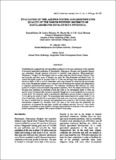Evaluation of the aquifer system and groundwater quality of the north-western districts of Bangladesh for development potential
Date
2016Publisher
© 2016 Published by BRAC UniversityAuthor
Islam, KamrulRahman, M. Saidur
Ali, M. Hazrat
Hossain, A.F.M. Afzal
Alam, M. Jahangir
Zahid, Anwar
Metadata
Show full item recordCitation
Islam, K., Rahman, M. S., Ali, M. H., Hossain, A. F. M. A., Alam, M. J., & Zahid, A. (2016). Evaluation of the aquifer system and groundwater quality of the north-western districts of Bangladesh for development potential. BRAC University Journal, XI(2), 85–100.Abstract
Considering the comparatively low agricultural production in the area, assessment of the potential
of increased agricultural production in Panchagarh, Thakurgaon, Dinajpur and Joypurhat districta
was undertaken, through optimum utilization of available water resources. Physiographically,
Thakurgaon, Dinajpur and Panchagarh areas are mostly under the Old Himalayan Piedmont Plain
and Joypurhat and some areas of Dinajpur are under the Tista floodplain and Barind Tract. To
explore the aquifer system in the area, a total of 15 new test drillings were cnoducted down to the
maximum depth of 300 m and 50 observation wells were selected for observing the groundwater
level trend. Groundwater samples were collected from 20 locations for analysis and interpretation
of important physicochemical parameters. The important constitoenta that influence the water
quality for inigation were calculated using standard equations. From the spatial distribution of the
borelogs from northwest to southeast reveals that down to the investigated depth of 300m the
aquifer system is hydraulically connected regionally though one or more aquitards are encountered
at local level. The maximum depth to groundwater table below ground surface is between 4.0 to
12.0 m doring dry month of April. The groundwater table lowers beyund the suction limit (7.5 m)
of no. 6 hand tube wells (HTW) in some parts of the study area. In geneml, groundwater quality of
the areas is suitable both for domestic and agricultural uses except at a few localities where iron
concentration exceeded the allowable limit. The most of the study area has potentiality for
groundwater development having higher rainfall and recharge potential. However, when usable
recharge is considered at base condition, shortage of groundwater is observed in few areas and no
further installation of irrigation TWs is recommended in those areas.

